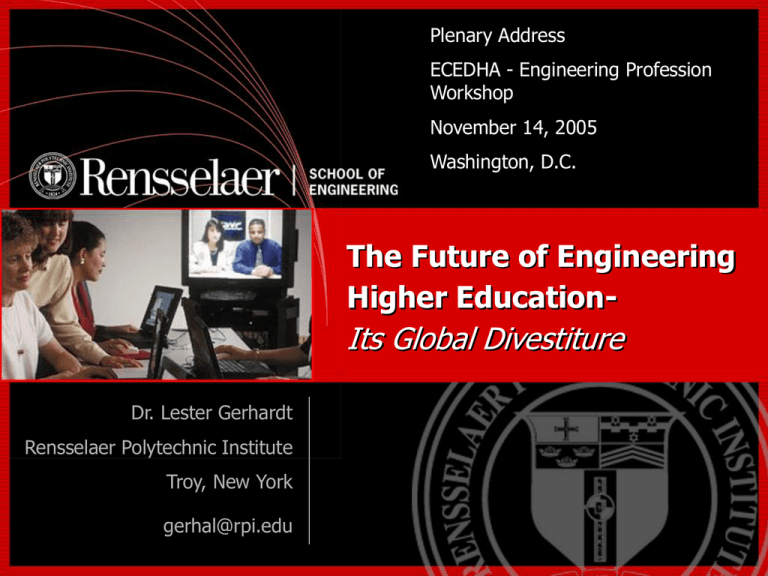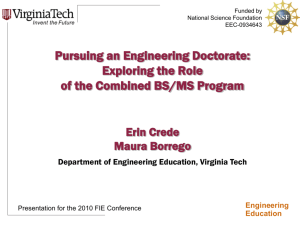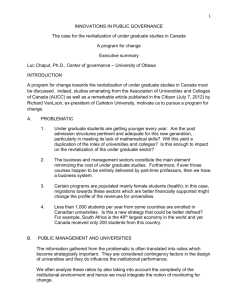Globalization of Education Distance Learning
advertisement

Plenary Address ECEDHA - Engineering Profession Workshop November 14, 2005 Washington, D.C. The Future of Engineering Higher Education- Its Global Divestiture Dr. Lester Gerhardt Rensselaer Polytechnic Institute Troy, New York gerhal@rpi.edu What’s Happening in… China More Students in Colleges & Universities (20 million) than US, India, Russia, Japan Doubled Number of S & E PhDs From 1996-2001 to Greater Than 8,000 Beijing Geely University, one of 1,300 Private Universities – 20,000 Students @ $1,000/yr Tsinghua University – the MIT of China – Most Faculty Studied Abroad, English Popular Applications to US Down 60% in Last Two Years What’s Happening in… India More Stay in India for Higher Education Than Ever Before 12,000 Seats in 54 Engineering Institutions Berkeley, UCSD, CMU, Cornell, SUNY@Buffalo & Case Western 3 Year MOU with India (AMRITA Univ.) for Satellite Learning Network Funded by QUALCOMM, Microsoft, Cadence Applications to US Down More Than 40% in Last Two Years What’s Happening in… Malaysia Private Universities Developed by Industry Teaching in English Germany BS, MS, PhD Degree Structure Teaching in English ECTS Everywhere For The US – A Changing Scene From a ‘Virtual Monopoly’ in Higher Education to Formidable International Competition The ‘ATT Divestiture Equivalent for Higher Education’ Single Digit Percentages of UG International Students High Double Digit Percentages of Graduate International Students A Contradiction? Engineering Has Held a Supremacy Role in the United States and in its Development BUT The US Now Graduates 15,000 Fewer Engineers Annually Than It Did 20 Years Ago AND Europe and Asia Produce 3-5 Times As Many Engineers As The US Which Are Available at 20%-30% the Cost of a US Engineer AND Many International Schools have Substantial Equivalency and Are Seeking Full Accreditation A Typical University Circumstance 70% International Applications Admissions of International Students Constrained by the Need for Providing Full Tuition and Stipend One Half of Graduate Student Body is International One Half of Those are From China From Which US Applications Have Dropped 60% in Two Years International Applications Country Application Change ’03-’04 Application Change ’04-’05 China Down 45% Down 13% India Down 28% Down 9% South Korea Down 14% Down 0% US Graduate Enrollment in Science and Engineering – 2003* All Time High of 474,203 Up 4% Over 2002 Up 9% Over 1993 Full time Students at 72% Growth in All Fields Except Computer Science Postdoctoral Appointments at All Time High at 33,685 Women at 42% Up From 36% in 1993 US Graduate Enrollment in Science and Engineering – 2003* Underrepresented Minorities Increased First Time Full time Enrollment of Students with Temporary Visas Declined for the Second Year in a Row Decline of 6% From 2001 to 2002 Decline of 8% From 2002 to 2003 * http://www.nsf.gov/statistics/infbrief/nsf05317/ 2005 CGS International Graduate Admissions Survey III Increase in First Time Enrollment China-3%, India-3%, Korea-5%, Middle East-11% First Time International Enrollment by Field Engineering- up 3% Physical Sciences- up 1% The Rise of Competition in Graduate Education: Some Indicators Europe produced more PhDs than US in 2003 Asia produced more PhDs than US in 2003 Application for Graduate Study in US is Down Bachelors (3 Yr. Becoming Standard in EU), Masters, PhD Format Adopted in Europe & Asia Cost Cooperation within EU & within Asia All seeking diverse student population Increased Teaching in English Barrier Erosion of Global Education Technology Travel Distance Learning Language Diversity of Culture Uniformity of Process Best in Class Multi-National Corporations & EWP Competition & Cooperation The Reality A Technologically Borderless Planet A Globally Interactive Economy A Distributed Educational System A Global Engineer is Needed Balancing Cooperation and Competitive Position Specific Emphasis On: Globalization of Education Distance Learning Proper Use of Advanced Technology Could and Should Accelerate Both Generations of Distance Learning Technology* Broadcast Technologies Same Instructional Model Interactive Video + Initial Internet Usage Websites, Electronic Course Material (e.g. MIT) Similar Instructional Model *Kim A. Scalzo, Director, Distributed Education & Multimedia, Rensselaer Generations of Distance Learning Technology* Internet Technologies 2-way Communications + Collaboration Increased Interaction between Students and with Professor Virtual Learning Online Conferencing, Chat Rooms Needs Change in Instructional Model Extension to Online Journal Publication (e.g. ASEE) *Kim A. Scalzo, Director, Distributed Education & Multimedia, Rensselaer Generations of Distance Learning Technology* Future Technologies Wireless Devices (PDA, Blackberry, etc.) Revolution in Instruction Innovation in Learning *Kim A. Scalzo, Director, Distributed Education & Multimedia, Rensselaer Distance Learning for ? Undergraduate Students Graduate Students US Need for International Exchange 96% of Humanity Lives Outside the U.S. Borders 13 Million Americans in Higher Education 175,000 (1.35%) of Those Have an International Education Experience Annually 5,000 (0.04%) of Those are Engineering Students United States Internationalization in Higher Education “Crying in the Wilderness” Global Engineering Education Exchange Program Characteristics Tuition Paid at Home Institution Room & Board Paid at Host Institution Zero Net Flow of Student Semesters Full Credit Transfer of Courses Geographically and Temporally Integrated Policy on Grades Determined by Individual University Members Course Data Bank Voluntary A Need For Global Quality Assurance Students Exchanged Courses and Credits Exchanged Research Experiences Exchanged Dual/Joint Degrees Mandates A Move From Substantial Equivalency To International Accreditation The Future Homogeneity of the Process Heterogeneity of the Students A Trend to Uniformity A Trend to Diversity Safety Go Anywhere, Do Anything Insulating Bubble Homogeneity of the Process: Common Practices English Becoming More Prevalent in Universities DTU, Budapest University, Tohoku University, Nanyang University, etc. Master Degree in Information Technology at TU Munich in English Homogeneity of the Process: Common Practices Erasmus Program Large Scale Partnerships Between European Universities Joint Degree Programs European Credit Transfer System – ECTS Common Standards and Practices within Europe Homogeneity of the Process: Common Practices ABET 2000 Outcome Assessment Based US and European Adoption Bologna Declaration More Unified Higher Education Approach Two-Cycle Bachelor’s and Master’s Across Europe Credit Accumulation System Quality Assurance and Accreditation Systems Heterogeneity of the Students Large Number of International Graduate Students in the U.S. 572,509 in ’03/’04 overall 274,310 (of 1,893,736 US graduate students-14.5%) U.S. and Asian Students Sought in European Universities University Consortia – Global Draw Virtual Universities Country Independent Internationalization Graduate vs. Undergraduate Reputation of Professor Reputation of Field Research Content Focused Education Research Credit Desired Reputation of University Knowledge – Credit Credit – Knowledge Internship More Important Internship Optional Course Content Focused Education Course Credit Desired Internationalization Graduate vs. Undergraduate Time to Degree More Flexible Time to Degree Well Defined Interdisciplinary Focus Disciplinary Focus No Consortium Based Program Financial Aid Expected Global Eng. Education Exchange [Global E3] Financial Aid Critical English/Other Language English/Other Language The Future Changing Face of Competition Traditional Campus Based University Distance Learning Virtual University Industry Based University International Competition Increasing A Global Virtual University Degree Credit Requirements Competition Domestic Global Traditional Campus Based Universities Distance Learning Based Universities University of Phoenix, NTU, etc. Corporate Based Universities Kettering, Motorola, etc. Teaching in English High Quality Seeking Student Diversity Many Tuition Free Competition Domestic Global Traditional Campus Teaching in English Based Universities High Quality Distance Learning Seeking Student Competition AND /or Cooperation Based Universities Diversity University of Phoenix, NTU, etc. Corporate Based Universities Kettering, Motorola, etc. Many Tuition Free Required Aspects of Engineering Higher Education Breadth and Depth Academic and Research Integration Flexibility Disciplinary, Multidisciplinary, Interdisciplinary Skill/Tool based Communication and Language, Leadership, Entrepreneurship, ‘Work and Play Well’ with Others Societal Impact Understanding and Appreciation Selected Responsibilities of the UniversityBoth Cultural and Technical Integrate Research and Academic Programs Match Global Needs With Degree Objectives Individual and Collective Responsibility Educational Outreach-Both K - 12 and EWP Promote Diversity Women-the Underrepresented Majority Underrepresented Minorities Leading and Reacting to Change Engineering Educational Methodology Current Popular Paradigm Evolve Disciplinary to Multidisciplinary to Interdisciplinary Evolve from the Simple to the Complex Bottom up An Alternative Paradigm* Evolve Interdisciplinary to Multidisciplinary to Disciplinary Evolve From the Complex to the Simple Top down *Gary Gabriele- JEE, 7/05 Engineering-Commodity or Profession? Engineering as a Profession Click here for bullet Engineering as a Profession Degrees Licensing Bachelors-Too much to learn, too few credits; core engineering; global experience; conflict of 3 yr. vs. 5 yr. degree Masters-First Professional Degree Doctorate (and postdoc) Accredited Professional degree, experience, continual renewal (EWP), and validation Professional Organization Leadership National role in public policy, government, industry, university The Future European Community United States Asian Community Extending Global Markets Africa Latin America Middle East Other Selected Issues: Pebbles, Rocks, Boulders Conflict of (Decreasing) Technological Time Constant with Longer Cultural/Societal Time Constants Privacy and Security Course Content and Quality Homogeneity of ‘Process’ and Heterogeneity of ‘Product’ Selected Issues: Pebbles, Rocks, Boulders Measuring & Evaluating Outcome Assessment A Seamless Flow of Basic and Continuing Education Managing the Global University Degree Granting Differential Tuition Balancing Cooperation & Competition The Future University Sector PUSH University Sector PUSH Industry Sector Industry PULL Sector PULL The Future University Sector PUSH Industry Sector PULL Relentless Pursuit of Wisdom From Courses and Degrees Discrete ‘Packages’ To Data and Information Continuous Flow To Knowledge and Wisdom Constancy of Learning A Global Approach and Global Quality Assurance is the Only Long Term Option The World is Flat Click here for bullet





